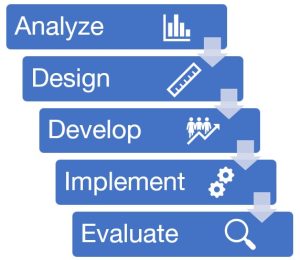Lesson 4 Getting Started in Course Design
4-1 ADDIE
Instructional Systems Design Model: ADDIE

Analyze, Design, Develop, Implement, Evaluate – this sequence of stages, or something similar, will probably sound familiar to experienced trainers or teachers. ADDIE was originally developed for military training for efficiency and effectiveness; it’s the tried and true model for developing instructional materials from print to e-learning. Read more about ADDIE in the Instructional Designer’s Handbook from Penn State.
This course (course 1 of the certificate) focuses mostly on the analyze and design aspects. You will complete these two phases using a project of your own design–see Capstone Project Description. In course 2, you try out different development tools, and course 3 focuses on evaluation and assessment. The final course is the capstone where you will finally create/implement some aspect of that e-learning project.
In this series of short videos, you see each stage of the ADDIE model discussed in creative detail. They are roughly 5-6 minutes long. Click each button to view each video.
Analysis
Design
Development
Implementation
Evaluation
There isn’t an adequate ready-made, one-size-fits-all design process, even for classroom-based learning, and the e-learning environment throws a number of wildcards into the equation. However, all educators – industry trainers, K-12 teachers, college professors, etc. – can use modifications of the basic ADDIE process to remind themselves of the desirable sequence of phases for creating learning experiences. Although there is considerable variation in how the specific stages play out in different fields, ADDIE provides an excellent general map for anchoring the instructional design process.
⭐ Shar’s Note: When you’re in an interview, be sure to mention ADDIE with examples of how you’ve worked through the phases. This design model is basic knowledge for any instructional designer.
